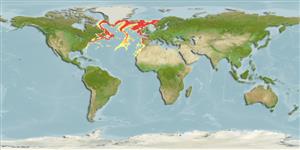Preferred temperature (Ref.
123201): 2.7 - 9.4, mean 4.5 °C (based on 270 cells).
Phylogenetic diversity index (Ref.
82804): PD
50 = 0.5000 [Uniqueness, from 0.5 = low to 2.0 = high].
Bayesian length-weight: a=0.00214 (0.00109 - 0.00421), b=3.20 (3.03 - 3.37), in cm total length, based on LWR estimates for this (Sub)family-body shape (Ref.
93245).
Nível Trófico (Ref.
69278): 3.7 ±0.56 se; based on food items.
Resiliência (Ref.
120179): Baixo, tempo mínimo de duplicação da população 4,5 - 14 anos (K=0.1; tm=9-11; tmax=54; Fec=10,000).
Prior r = 0.27, 95% CL = 0.18 - 0.40, Based on 4 full stock assessments.
Fishing Vulnerability (Ref.
59153): High to very high vulnerability (72 of 100).
🛈
Climate Vulnerability (Ref.
125649): Moderate vulnerability (38 of 100).
🛈
Nutrients (Ref.
124155): Calcium = 17.4 [5.5, 40.4] mg/100g; Iron = 0.296 [0.130, 0.842] mg/100g; Protein = 17.3 [15.4, 19.0] %; Omega3 = 0.104 [0.041, 0.263] g/100g; Selenium = 26.9 [9.0, 74.3] μg/100g; VitaminA = 21.2 [2.7, 168.7] μg/100g; Zinc = 0.429 [0.232, 0.866] mg/100g (wet weight);
